Fairy Glass |
|||||||||||||||||||||||||||||||
 |
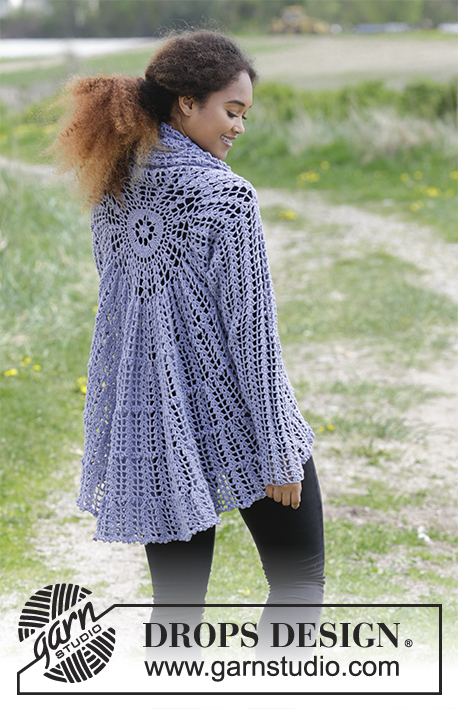 |
||||||||||||||||||||||||||||||
Crochet jacket worked in a circle with fan pattern. Size: S - XXXL Piece is crocheted in DROPS BabyMerino.
DROPS 181-26 |
|||||||||||||||||||||||||||||||
|
INFORMATION FOR PATTERN: MAGIC CIRCLE: To avoid hole in the middle beg with this technique: Hold yarn end in the left hand and make a loop around left index finger (from left to right). Hold the loop with left thumb and index finger. Insert hook through loop, get the yarn from ball, pull yarn through loop, make 1 yarn over and pull yarn over through stitch on hook = 1 double crochet, work 4 chain stitches (= 1 double treble crochet), then work 15 double treble crochets around loop, finish with 1 slip stitch in 3rd chain stitch = 16 double treble crochets. Pull yarn end tighten loop together so that the hole in the middle disappears. Then work as explained in pattern. PATTERN: See diagrams A.1 to A.6. FAN: 1 fan = 2 double treble crochets, 2 chain stitches and 2 double treble crochets worked into a chain space. CROCHET TOGETHER: See diagram A.6. Decrease 1 repetition as follows: Work 1 double treble crochet in first chain space but wait with last pull through. Work next double treble crochet in next chain space but wait with last yarn over and pull through. Work next double treble crochet in last chain space and pull last yarn over through all 4 loops on hook. On next round skip the double treble crochets worked together. ---------------------------------------------------------- JACKET WORKED IN A CIRCLE: Worked in the round from mid back on the back. Work the sleeves at the end. Work a MAGIC CIRCLE - see explanation above, on hook size 3.5 mm with Baby Merino. Then work according to A.1 - NOTE: First round in A.1 is explained below magic circle. Work 4 repetitions of A.1b in the round on every round. A.1a shows how round begins and ends. REMEMBER THE CROCHET TENSION! When A.1 has been worked, there are 28 groups of double treble crochets / 56 double treble crochets on round. Work from 2nd round in A.2 as follows: Work A.2a (shows how round begins and ends), continue with A.2b in the round (= 14 repetitions). Work A.2 1 time vertically = 84 treble crochets/chain spaces. Work from 2nd round in A.3 as follows: Work A.3a (shows how round begins and ends), continue with A.3b in the round (= 42 fans/double treble crochets). Work from A.2: 3rd round 1 time and 4th round 4-5-6 times (= 6-7-8 rounds in total with fans and double treble crochets). ARMHOLES: Work next round as 4th round in A.2 (fans and double treble crochets), at the same time work as follows: Work the first 5 repetitions as before (1 repetition = 1 double treble crochet, 1 chain space, 1 fan, 1 chain space ), work 1 double treble crochet in next double treble crochet, work 40-44-48 new chain stitches, skip next fan and the next 5-6-7 repetitions, (skip 6-7-8 fans and 5-6-7 double treble crochets in total = armhole), work as before in the next 20-18-16 repetitions, work 1 double treble crochet in next double treble crochet, work 40-44-48 new chain stitches, skip next fan and the next 5-6-7 repetitions, (skip 6-7-8 fans and 5-6-7 double treble crochets in total = armhole), work as before in the last 5 repetitions. Work next round as follows: Work 5th round in A.2, around chain spaces for armhole work 6-7-8 repetitions of A.2 (= 36-42-48 treble crochets with 5 chain stitches between each) = 42 repetitions in total of A.2 (= 252 treble crochets in total with 5 chain stitches between each). Work from 2nd round in A.4 as follows: Work A.4a, continue with A.4b, but 10 times evenly on round (= approx. every 4th repetition work A.5b instead of A.4b to increase) = 52 repetitions of A.4. Work from 2nd round in A.2 as follows: Work A.2a, continue with A.2b in the round = 52 repetitions of A.2. On next round continue from 3rd round in A.2a and A.2b. When 4th round has been worked vertically, repeat this round 3-4-5 more times (= 6-7-8 rounds with fans/double treble crochets in total). Work next round as follows: Work 5th round in A.2 (= 312 treble crochets with 5 chain stitches between each). Work from 2nd round in A.4 as follows: Work A.4a, continue with A.4b, but 10 times evenly on round (= approx. every 5th repetition work A.5b instead of A.4b to increase) = 62 repetitions of A.4. Work from 2nd round in A.2 as follows: Work A.2a, continue with A.2b in the round = 62 repetitions of A.2. On next round continue from 3rd round in A.2a and A.2b. When 4th round has been worked vertically, repeat this round 3-4-5 more times (= 6-7-8 rounds with fans/double treble crochets in total). Work next round as follows: Work 5th round in A.2 (= 372 treble crochets with 5 chain stitches between each). Work from 2nd round in A.4 as follows: Work A.4a, continue with A.4b, but 10 times evenly on round (= approx. every 6th repetition work A.5b instead of A.4b to increase) = 72 repetitions of A.4. Work from 2nd round in A.2 as follows: Work A.2a, continue with A.2b in the round = 72 repetitions of A.2. On next round continue from 3rd round in A.2a and A.2b. When 4th round has been worked vertically, repeat this round 3-4-5 more times (= 6-7-8 rounds with fans/double treble crochets in total). Work next round as follows: Work 5th round in A.2 (= 432 treble crochets with 5 chain stitches between each). Work from 2nd round in A.4 as follows: Work A.4a, continue with A.4 b, but 20 times evenly on round (= approx. every 3rd repetition work A.5b instead of A.4b to increase) = 92 repetitions of A.4. Work from 2nd round in A.2 as follows: Work A.2a, continue with A.2b in the round = 92 repetitions of A.2. On next round continue from 3rd round in A.2a and A.2b. When 4th round has been worked vertically, repeat this round 3-4-5 more times (= 6-7-8 rounds with fans/double treble crochets in total). Work next round as follows: Work last round in A.2 (= 552 treble crochets with 5 chain stitches between each). Fasten off. Piece measures approx. 120-130-140 cm in diameter. SLEEVES: Work in the round from armhole and down. Begin mid under sleeve: In the side where fans were skipped. Work as last round in A.2 BUT with only 1 chain stitch between treble crochets, then work 36-42-48 treble crochets with 1 chain stitch between each from the other side of armhole = 72-84-96 treble crochets/chain stitches. Work 2nd round in A.4 = 12-14-16 repetitions around armhole. Then work 2nd round in A.2. Continue with fans and double treble crochets as in 3rd and 4th round in A.2. When piece measures 3 cm from armhole, decrease 1 repetition under sleeve. See diagram A.6 and read CROCHET TOGETHER. Decrease alternately before and after mid under sleeve every 8 cm, 6 times in total = 6-7-8 repetitions remain on round. Fasten off when piece measures 54-54-54 cm. Work the other sleeve the same way, but start in the opposite side so that the round starts mid under sleeve. |
|||||||||||||||||||||||||||||||
Diagram explanations |
|||||||||||||||||||||||||||||||
|
|||||||||||||||||||||||||||||||
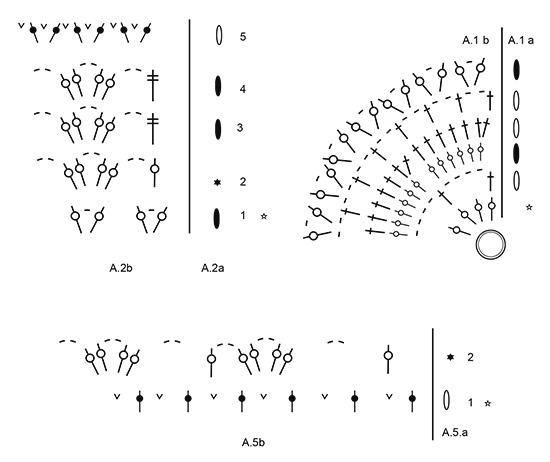
|
|||||||||||||||||||||||||||||||

|
|||||||||||||||||||||||||||||||
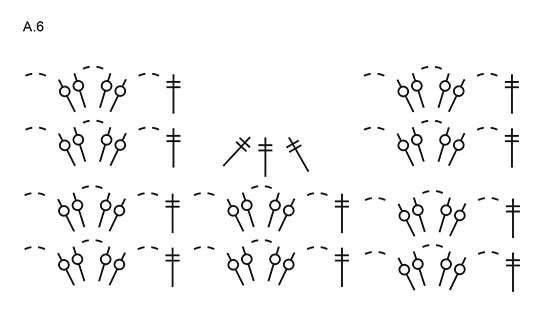
|
|||||||||||||||||||||||||||||||

|
|||||||||||||||||||||||||||||||
|
Have you made this or any other of our designs? Tag your pictures in social media with #dropsdesign so we can see them! Do you need help with this pattern?You'll find tutorial videos, a Comments/Questions area and more by visiting the pattern on garnstudio.com. © 1982-2024 DROPS Design A/S. We reserve all rights. This document, including all its sub-sections, has copyrights. Read more about what you can do with our patterns at the bottom of each pattern on our site. |
|||||||||||||||||||||||||||||||







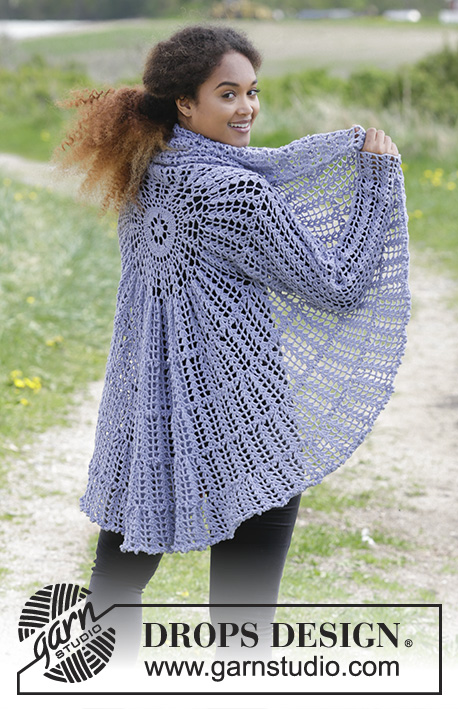
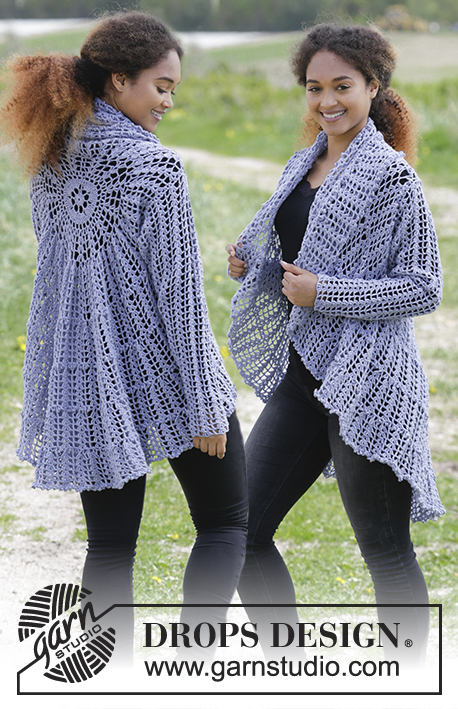


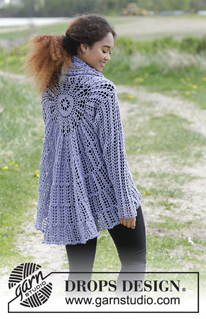




















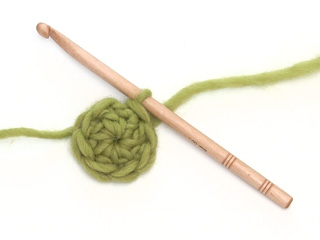

























Comments / Questions (45)
I do not know how to crochet from a diagram. I really want to make this sweater. Can I get the pattern in a written form?
15.10.2020 - 05:33DROPS Design answered:
Dear Teresa, we only have diagrams to this pattern, but you will get helped with this lesson explaining how to read crochet diagrams. Happy crocheting!
15.10.2020 - 09:14Hallo, ich bin gerade bei der Runde nach den Armausschnitten, die 5. Reihe von A2 ist erledigt (252 Stäbchen mit 5 Luftmaschen dazwischen). Ich komm jedoch in der Runde danach (A4b bzw. A5b) nicht auf die in der Beschreibung angegebenen 52 Rapporte. Bei den 252 Stäbchen/Luftmaschenbögen gehen sich nur 42 Rapporte aus (für 52 Rapporte würden 312 Stäbchen/Luftmaschenbögen benötigt). Ist die Beschreibung falsch oder die Grafik von A4/A5?
20.08.2020 - 20:58DROPS Design answered:
Liebe Anja, Sie hatten 42 Mal A.2 in der Breite gehäkelt = 42 x 6 Stb in jedem A.2 = 252 Stb. Jetzt häkeln Sie A.4 (über 6 Stb = 1 Rapport von A.4) 32 Mal in der Runde aber gleichzeitig häkeln Sie A.5 (= über 6 Stb häkeln Sie 2 Rapporte von A.4) insgesamt 10 Mal bei der Runde. Dh ungefär so: (A.4 x 4, A.5) in der Runde häkeln. = jetzt haben Sie: 42 Rapporte von A.4 + 10 Rapporte (in A.5 zugenommen) = 52 Rapporte von A.4 in der Runde. Viel Spaß beim häkeln!
21.08.2020 - 08:12I was just wondering if I could get some clarification on the sleeves. When it says, "...Decrease alternately before and after mid under sleeve every 8 cm / 3 1/8'', 6 times in total = 6-7-8 repetitions remain on round..." does that mean decrease once before the mid, do a round with no decreases, and then on the next round decrease after the mid? Or does it mean to decrease before and after the mid, then a round with no decreases.
05.08.2020 - 23:34DROPS Design answered:
Hi Adrian, This means you decrease just once every 8 cm, so the first time before mid under sleeve, then work 8 cm and decrease again but this time after the mid under sleeve. A total of 6 decreases means you have then worked 48 cm. Hope this helps and happy crocheting!
06.08.2020 - 07:10After the armholes, when I have 52 repetitions of A4&5, do I continue with 2nd round of A2 in every chain space, including fan? If so I will have way too many repetitions. I keep referring to the photos but I don't think they match this section of the pattern.
07.07.2020 - 14:14DROPS Design answered:
Dear Mrs English, you work 1 repeat of A.2b over 1 repeat of A.4 from previous round, ie you had 52 repeats A.4 on previous round, you work now 52 repeats as before but following now A.2b (with A.2a at the beg of the round). Happy crocheting!
07.07.2020 - 15:32Also having trouble after armholes. I have the 252 double crochets, but skipping 2 chain spaces looks gappy and doing 4b three times, then 5b gives me 43 repetitions. It just doesn't add up and it doesn't look like the photos. The photos look like you just skip one chain space. Can you clarify?
05.07.2020 - 23:34DROPS Design answered:
Dear Mrs English, not sure to understand completely what you mean - after you have worked the 2 chain spaces for armholes (skipping stitches), you then work the 5th row in A.2 around (= as before), in both chain-spaces for armhole (where you skipped 5-6-7 repetitions), work now 6-7-8 repetitions = 252 sts in total (with 5 ch-sts between each) and the round continue as if there weren't any "holes" for the armholes. Hope this will help :) Happy crocheting!
06.07.2020 - 09:13Har problem som flera andra med varvet a4b och där man ska virka a5b fördelat 10 ggr. Hur jag än tänker och försöker får jag inte 52 rapporter virkade när jag är klar. Jag får 32 a4 och 10 a5 enligt beskrivningen ska jag ha 52 a4 vad jag kan läsa. Vad är det som inte stämmer
09.04.2020 - 01:16DROPS Design answered:
Hej Anette, jo men i A.5 har du 2 rapporter, så hvis du har 32 rapporter i A.4 og 10x2 rapporter i A.5, så bliver det ialt 52 rapporter :)
29.04.2020 - 09:39I love this pattern (Fairy Glass) and others like it. I was wondering if it would be possible to make it in a slowly graduating yarn (such as the Wolltraum My Melodyy range). I see it working well for the body, but not sure about the sleeves. If that wouldn't work for this pattern, is there a similar one that I could do this with?
09.11.2019 - 14:52DROPS Design answered:
Dear Sylvia, please understand that we cannot advise you on using yarns other than the DROPS range. Generally with self striping / graduating yarns the colors on the sleeves will have a different rythm than on the bogy. Happy Crafting!
10.11.2019 - 11:26I love the pattern but I do not understand the pattern, i need it in American English, I pressed the key for it to be converted , but nothing happen, i would like to have this pattern, how do I get it in english.
18.09.2019 - 08:24DROPS Design answered:
Dear Sarah, click on the scrolling down menu below photo and choose US-English to get the pattern with US-crochet terminology and measurements in inches. Happy crocheting!
18.09.2019 - 10:13So in other words, the next round after completing the arm hole paragraph of the pattern, and the 5th row of A2 is completed... will I work the next round similar to previous rounds with the exception of doing a repetition of A5, every 10 repetition? The diagram for A4. Which the pattern says to work 10 repetitions before a repetition of A5 is confusing. Not sure if it is worked like previous A2. Rounds or if I'm skipping more chain spaces
19.07.2019 - 18:59Kristin Blevins answered:
I have figured it out. The chart for A.4 is wrong and should be corrected. The chart says to skip two chain spaces between each fan and TC. In order to get the correct stitch count you only skip one chain space.
20.07.2019 - 02:34I am having issues after the arm hole. Where the switch back and forth between A4, and A5. Is it supposed to be skipping loops, it seems to be a decrease. The chart appears to read: TC, ch2, skip 2 chain sp, then work fan, chain 2, skip 2 chain space, this we do 4 times and then work A5. TC, ch2, skip home chain space, work fan, ch2, TC in next chain sp, ch2, skip 1 chain, work fan. Then switch back to the A4 round. Am I reading this correctly?
18.07.2019 - 18:31DROPS Design answered:
Dear MRs Blevins, working A.5b evenly instead of A.4b will increase the number of stitches = in each A.4b you have 1 tr + 1 fan and in each A.4b you will have 1tr,1 fan, 1 tr, 1 fan worked over the same number of stitches. Happy crocheting!
19.07.2019 - 07:39